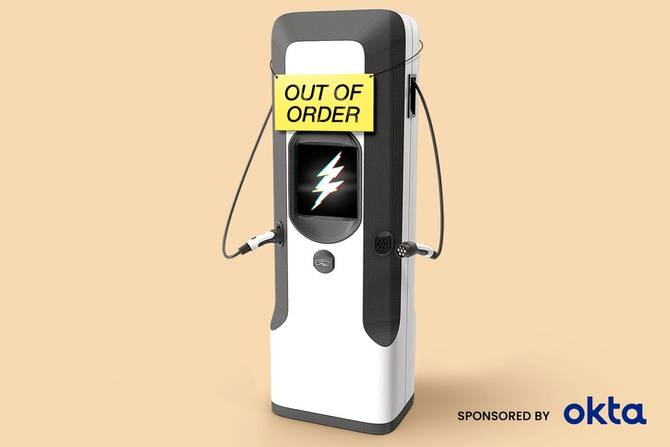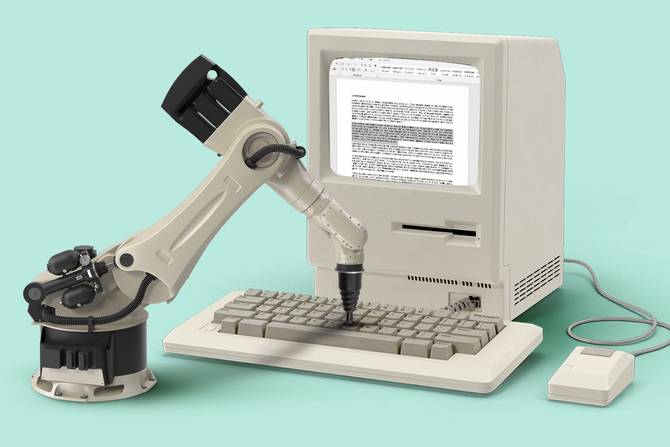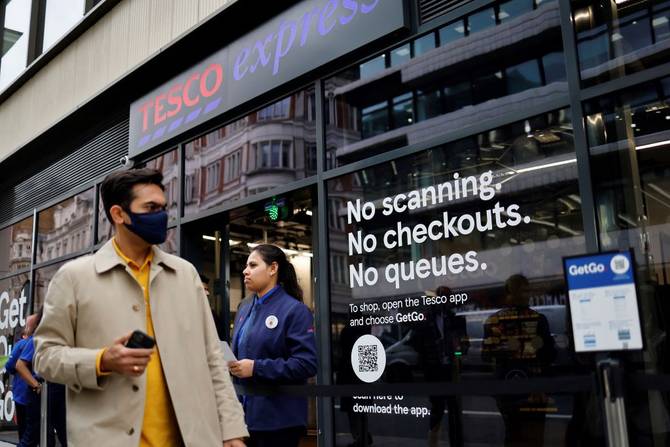It’s Wednesday, and Facebook (the company, not the app) is reportedly planning to change its name to highlight its metaverse ambitions. So far, there’s been some credible speculation around the words “Horizon” (FB has released apps with this name) and “Meta” (for obvious reasons).
We won’t use this space to speculate further...but we will ask all of you to. What’s your best (or funniest) guess? Hit reply to weigh in.
In today’s edition:
 EV charger cybersecurity EV charger cybersecurity
 A startup’s new large language model A startup’s new large language model
🛒 Tesco’s “just walk out“ tech
—Dan McCarthy, Hayden Field, Jordan McDonald
|
|
|
Francis Scialabba
If all goes according to (President Biden’s) plan, the US will have 500,000 public electric vehicle charging stations by 2030, up from about 43,000 today. And millions more home charging ports are expected to be installed across the country, as the vast majority of EV drivers fuel up at home.
Most of these charging ports will have some form of connectivity. And with great connectivity comes great responsibility...to ensure no one is hacking into EV charging networks and holding them hostage, stealing payment data, or hijacking them to manipulate the power grid.
The TL;DR: Charging networks and even individual at-home chargers are likely to face familiar security threats—ransomware attacks, data breaches—but they can also deploy familiar tools, like cybersecurity standards, to combat them.
Threat assessment
Jeff Hutchins, chief information officer of EOS Linx, an EV charging company that also builds solar-powered digital kiosks at its charging stations, told us the end user and centralized charging networks are likely to be the key targets.
“Denial of service, and service attacks—that’s going to be No. 1. But No. 2 is going to be the account hack,” Hutchins said. “If you read the big news in the last five years or so, it’s been everybody [getting] a free monitoring service and a $14 check because they somehow got their accounts compromised. So you have to know that those are the things that are going to get gone after.”
Cybersecurity threats like denial-of-service attacks and account hacks are not unique to EV charging networks, but the fact that charging stations will soon be critical day-to-day infrastructure means the potential consequences are significant.
- On the higher-stakes end, hackers could cause “serious impacts to the electric grid,” according to Tannaz Banisadre, chief operating officer of Shell–owned EV charging company Greenlots. For example, a bad actor could try and destabilize the power grid by simultaneously turning a bunch of chargers on and off.
- And a denial-of-service attack could, for example, shut down highway chargers along a major corridor.
To protect against threats...Some charging companies are proactively adopting existing cybersecurity standards, like constant monitoring for abnormalities, layering and abstracting data, and allowing for hacked pieces of the network to be isolated. Hutchins, for instance, said he followed many of the NERC-CIP best practices for EOS Linx, which are the standards used to protect bulk power systems in North America.
- And Banisadre told us the EV charging industry is also working to define its own security protocols. with groups like the Electric Power Research Institute (EPRI), Society of Automotive Engineers (SAE), ISO, and CharlN.
-
There’s also a growing list of auto-focused cybersecurity providers, mostly based in the US and Israel.
Click here to read the full story.—DM
|
|
|
Francis Scialabba
SambaNova Systems, a Palo Alto–based AI startup, announced a new language service model of a familiar variety. It’s a GPT, or Generative Pre-trained Transformer model, and has no links to OpenAI’s GPT series of language models.
SambaNova markets their GPT as an everyman’s alternative to OpenAI’s GPT-3, writing in the press release that it will allow companies “to be up and running with a customized language model in as fast as one month as opposed to nine months or a year.”
What it’s all about: You may have heard of SaaS (Software as a Service) or IaaS (Infrastructure as a Service), but SambaNova Systems offers DaaS: Dataflow-as-a-Service. The aim is to sell a suite of AI tools, including natural language processing ones, for startups to adopt quickly and seamlessly.
-
And the company has raised a total of $1.1 billion since its 2017 founding.
GPT is the latest tool in its box: a model that can both produce and process natural language. It’s built for enterprise use cases, according to the company. Think: extracting information from financial documents, managing health records, automating invoices, and more.
- The language model also offers “sentiment analysis”—e.g., categorizing the type of conversation or potential emotions involved in customer support, as well as analyzing positive/negative feedback about the brand and its reputation.
But, but, but: If you’re a longtime Emerging Tech Brew reader, you know large language models are the subject of a hot-button debate in the AI world. Proponents say they’re beneficial for many of the use cases we just went over; critics say they’re biased, harmful, and under-vetted.
Either way, AI companies are trying to expand access and push adoption forward.
Click here to view this story on-site.—HF
|
|
|
|
If that makes your head spin, you’re not alone. That number is how quickly the next generation of supercomputers will be able to process data.
To put that computing power into perspective, we’ll put it this way: If all 7.7 billion people on earth completed one calculation per second for six years, it would equal what an exascale supercomputer can do in one second.
What does that mean for you? As it turns out, a lot.
With our partners at HPE, we take a look at three major ways exascale computing will change your life.
In the very near future, we will see revolutionary improvements in clean energy, weather tracking, and flight, but for the full picture, you’ll have to read the article.
Explore the scale of exascale.
|
|
|
Tolga Akmen/Getty Images
Tesco, the UK’s largest supermarket chain, is implementing “just walk out” tech for the first time in a trial run in its Holborn, London, location.
The trial, dubbed Tesco GetGo, will allow shoppers to buy groceries without scanning items or checking out at a till. The experiment follows a staff-only trial in the grocery store at Tesco HQ.
How it works: To enter the Holborn store, shoppers must download the Tesco mobile app. All items are then tracked and charged to a shopper’s Tesco account, via a QR code scanned by their phone. When they leave the store, receipts are delivered in minutes, the company says.
- Weight sensors and cameras will track shoppers throughout the store, cataloguing every item they choose before checking out.
- Tesco says it isn’t using facial recognition to track shoppers, but instead AI-based “skeleton outlines,” which identify individuals as they shop.
Looking ahead...Tesco GetGo is a first step for the British grocery chain to compete with Amazon Fresh, which also relies on seamless checkout in its stores. Amazon Fresh already has half a dozen stores in London, and 18 locations spread across the US.
Click here to view this story on-site.—JM
|
|
|
|
Hiring is hard. But it doesn’t have to be. Let BELAY find the superstar you need, twice as fast as you would on your own. They’re super selective, accepting fewer US-based contractors than Harvard does undergraduates. Check out BELAY’s secrets for a revolutionized workforce here.
|
|
|
Unsplash
Stat: US banks identified almost $600 million in potential ransomware payments this year, putting the figure on pace to double last year’s total. Oh, and the US Treasury thinks the number is even higher at…$5.2 billion.
Quote: “We’re less sharing our life, and we’re more, ‘Let’s play hide-and-go-seek, or let’s go to ancient Rome,’”—David Baszucki, CEO of Roblox said of the platform in comparison to traditional social networks
Read: How Apple became a CPU powerhouse.
Growing pains gains: Help Scout offers the custom tools you need to manage a growing business. Scout’s honor. Are you a customer support leader at an online business with 51–200 employees? Take a qualified meeting with Help Scout and get a $100 Amazon gift card.*
*This is sponsored advertising content
|
|
-
Facebook has started testing its Novi digital wallet in the US and Guatemala.
-
GlobalFoundries, one of the biggest contract chipmakers in the world, is seeking a $25 billion valuation in its upcoming IPO.
-
Google aims to be net-zero by 2030 without relying on offsets—meaning it will rely entirely on clean energy.
-
Alibaba announced a new, highly advanced data center chip, continuing the trend of tech giants designing their own semiconductors.
|
|
Tomorrow is the 25th anniversary of the Internet Archive.
The Internet Archive is the nonprofit behind a web-crawling tool called The Wayback Machine, and it has preserved pieces of the internet since 1996. Using the tool, you can travel back in time to Web 1.0 blogs, or even to MySpace in its heyday.
And maybe in the future, when newsletters are but a quaint memory of a pre-metaverse era, you can use it to read archives of this very newsletter.
|
|
A new paper in the scientific journal Joule suggests that recycled lithium-ion batteries are just as good as—and at times better than—batteries made from new materials.
- In tests that mimicked industrial settings, the researchers found recycled batteries had the same energy density as batteries made from newly mined materials.
Why this matters: There is a finite supply of the metals needed to make battery cathodes, like cobalt and nickel. Demand for EVs is expected to test the limits of what humans can pull out of the ground anew, meaning battery recycling will become an imperative.
|
|
Catch up on the top Emerging Tech Brew stories from the past few editions:
|
|
|
Written by
Dan McCarthy, Hayden Field, and Jordan McDonald
Was this email forwarded to you? Sign up
here.
|
ADVERTISE
//
CAREERS
//
SHOP
//
FAQ
Update your email preferences or unsubscribe
here.
View our privacy policy
here.
Copyright ©
2021
Morning Brew. All rights reserved.
22 W 19th St, 8th Floor, New York, NY 10011
|
|










